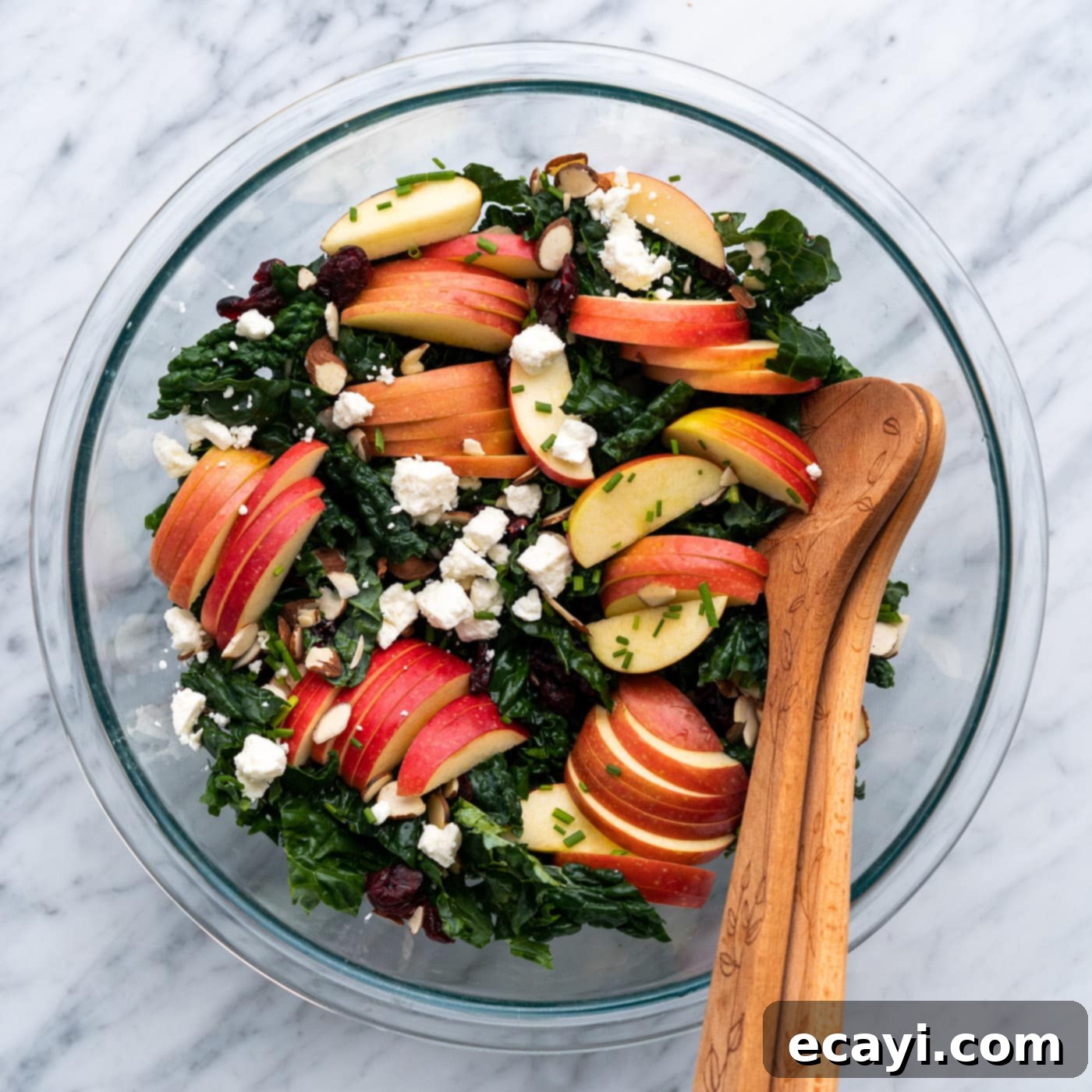Easy & Healthy Kale Salad with Crisp Apples, Feta, and Zesty Lemon Dressing
This vibrant and nutrient-packed kale salad offers a delightful symphony of flavors and textures in every bite. Featuring crisp apples, sweet-tart craisins, crunchy almonds, creamy feta, and fresh chives, all harmoniously tossed in a zippy homemade lemon dressing, it’s a salad that truly satisfies. Whether you’re seeking a light lunch, a wholesome side, or an impressive dish for entertaining, this recipe promises both ease and exceptional taste, making healthy eating utterly delicious.
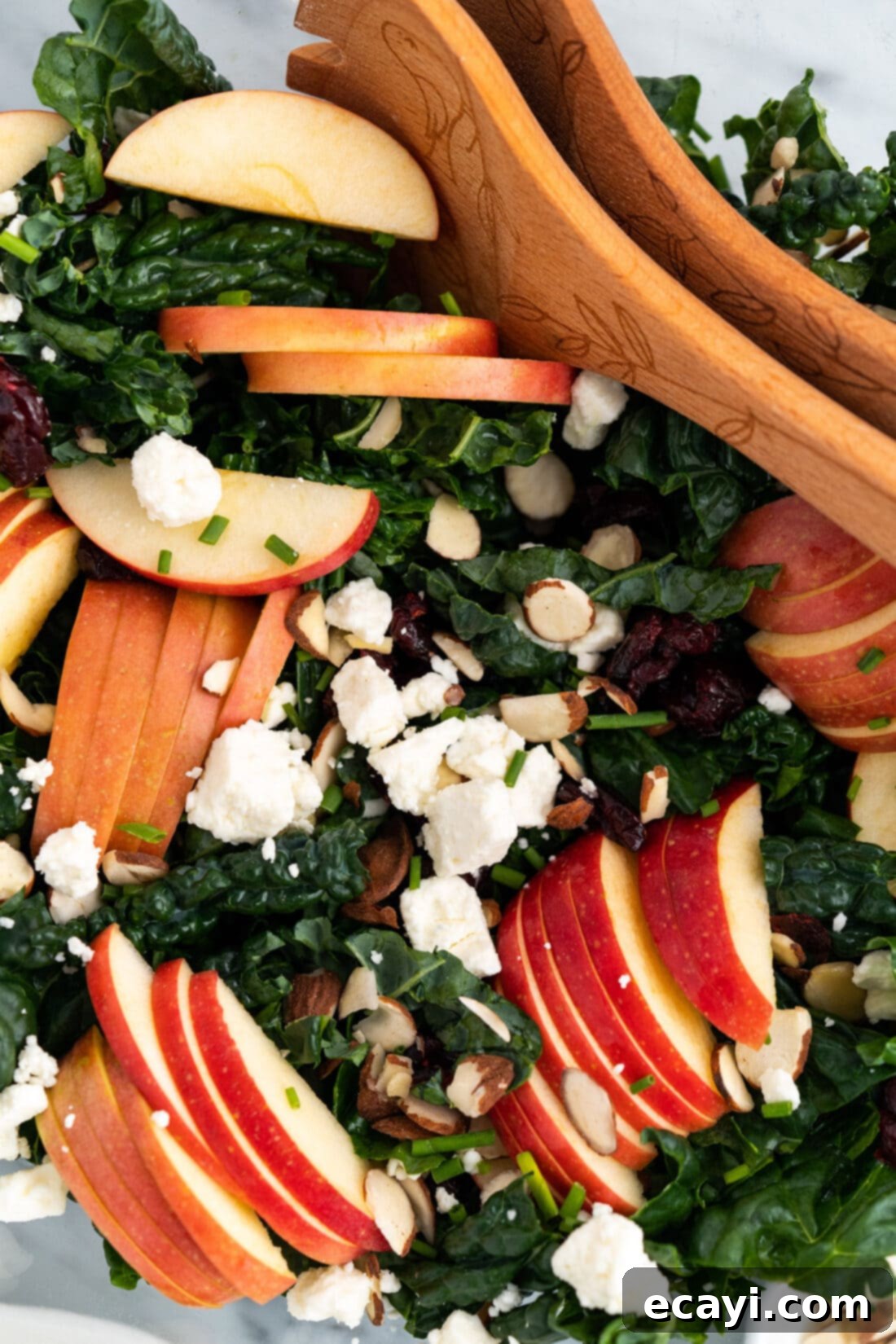
Why This Kale Salad Recipe is a Must-Try
Kale has earned its reputation as a nutritional powerhouse, and for good reason. This leafy green is brimming with vitamins K, A, and C, as well as essential minerals and antioxidants. While often blended into green smoothies or transformed into crispy kale chips, it truly shines when eaten raw in salads. Our recipe elevates raw kale, turning it into the star of a refreshing and surprisingly simple dish, complemented perfectly by a bright, homemade lemon dressing.
What makes this specific kale salad so exceptional is the thoughtful combination of ingredients that create a balance of textures and flavors. You get the satisfying crunch of fresh kale and apples, the delightful chewiness of dried cranberries (craisins), the earthy nuttiness of almonds, and the salty, tangy creaminess of crumbled feta. The fresh chives add a subtle oniony freshness that ties everything together. This dynamic interplay ensures every forkful is exciting and prevents the salad from feeling mundane.
Beyond its incredible taste, this kale salad is incredibly versatile. It serves as a fantastic foundation for customization, allowing you to tailor it to your preferences or whatever ingredients you have on hand. Feel free to experiment by tossing in or substituting with ingredients like thinly sliced raw beets, red onion for a sharper bite, juicy pomegranate arils for a burst of flavor, creamy avocado for richness, or tangy goat cheese instead of feta. For a more substantial meal, consider adding a protein source such as grilled chicken, roasted chickpeas for a vegetarian option, or thinly sliced beef.
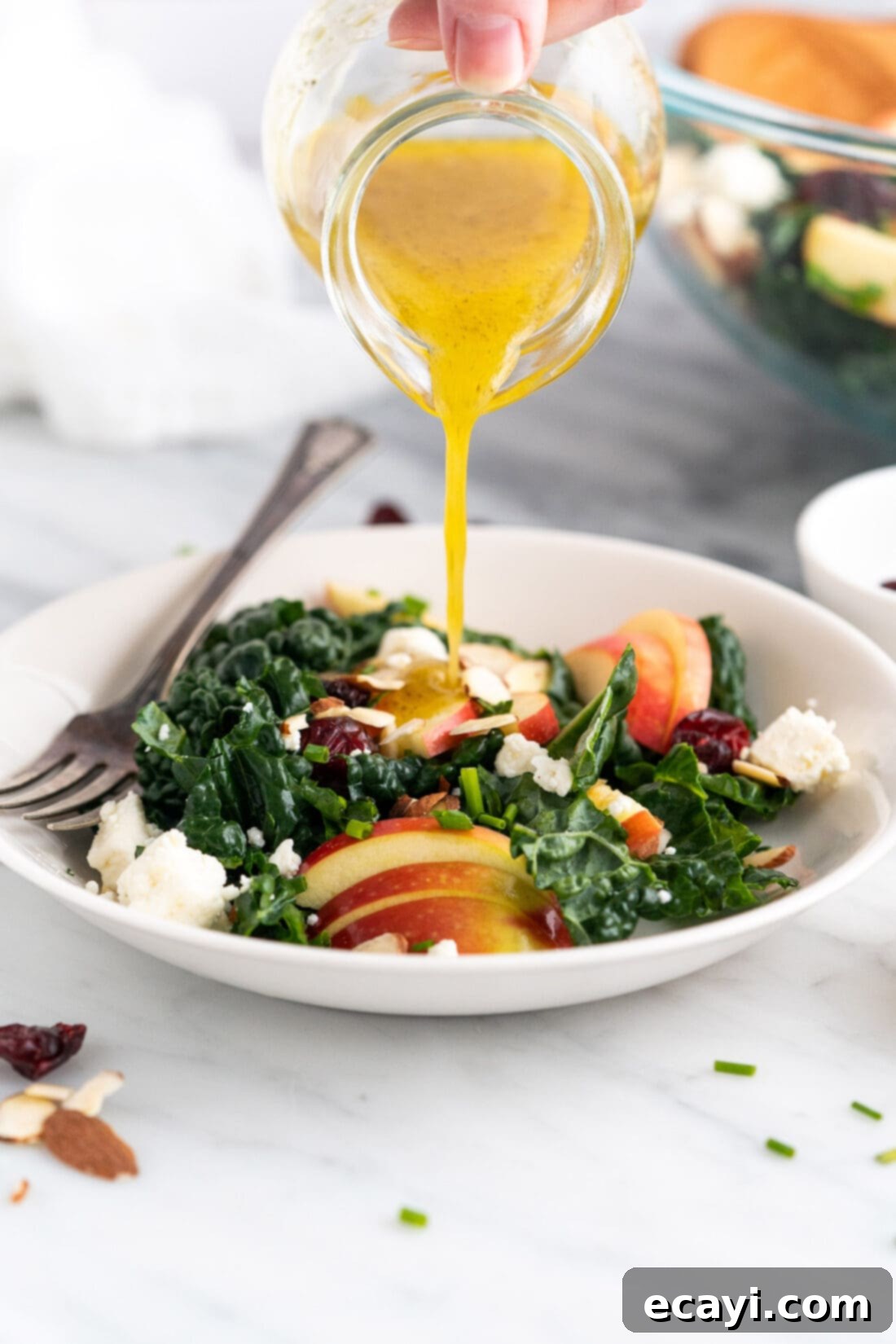
Key Ingredients for Your Delicious Kale Salad
Crafting this incredible kale salad starts with fresh, high-quality ingredients. While the full list of measurements and step-by-step instructions can be found in the printable recipe card at the end of this post, here’s a quick overview of what you’ll need to gather:
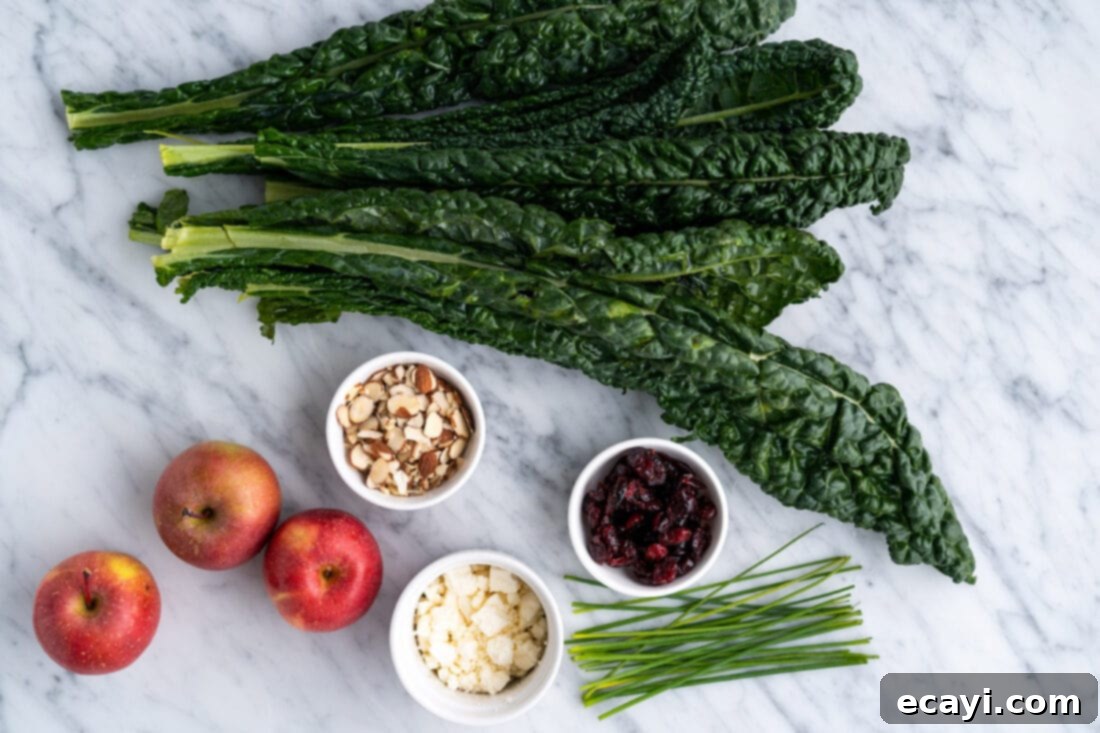
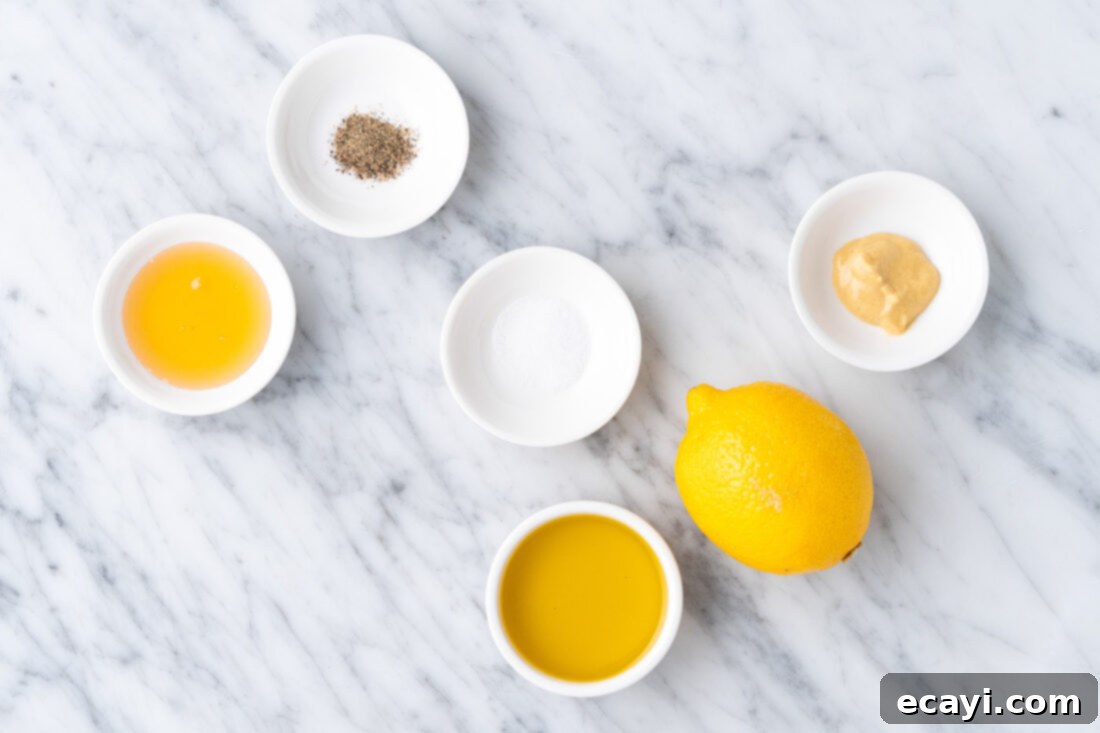
Ingredient Spotlight & Smart Substitutions
Understanding each ingredient and knowing how to adapt them allows for endless culinary creativity. Here’s a deeper dive into the components of this salad:
KALE – The foundation of our salad. To prepare kale for salads, it’s essential to remove the tough, fibrous stems. Simply hold a leaf by the stem and, with your other hand, slide down its length to separate the leafy part. The leafy greens are then chopped into bite-sized pieces. While curly kale is commonly used, feel free to experiment with different varieties like Lacinato (also known as dinosaur kale for its deep blue-green, crinkled leaves and slightly sweeter flavor), baby kale (tender and milder, requiring less massage), or Red Russian kale (known for its purplish stems and sweet, earthy flavor). Each type offers a slightly different texture and taste profile, making it a great ingredient to grow in your garden and enjoy fresh!
APPLES – Apples provide a crucial crisp texture and a lovely sweetness that beautifully balances the earthiness of kale. While the recipe suggests 3 small-ish apples, you can easily use 1 large or 2 medium apples. The key is to choose an apple variety you genuinely enjoy eating raw. Honeycrisp is a popular choice for its exceptional crispness and sweet-tart flavor, while Fuji apples offer a similar sweet crunch. Other excellent options include Gala for its mild sweetness, Pink Lady for its balanced flavor, or even Granny Smith if you prefer a more pronounced tartness to cut through the richness of the other ingredients.
DRESSING – Our homemade fresh lemon dressing is so good, it truly deserves its own spotlight! You can bookmark our dedicated lemon salad dressing recipe here for all its glory. It’s incredibly simple yet impactful, combining fresh lemon juice, extra-virgin olive oil, honey, Dijon mustard, salt, and pepper. The beauty of this dressing lies in its adaptability. To enhance its aromatic complexity, consider adding up to 1 teaspoon of finely minced fresh herbs like thyme, rosemary, oregano, or tarragon. For a subtle savory depth, a single clove of crushed garlic works wonders. Don’t hesitate to adjust the amount of honey to achieve your desired level of sweetness, ensuring it complements the tartness of the lemon and other salad ingredients perfectly.
CRAISINS (Dried Cranberries) – These little gems contribute a wonderful chewy texture and a burst of sweet-tart flavor that complements the apples and kale. If craisins aren’t your preference or readily available, you can easily substitute them with other dried fruits. Dried cherries offer a richer, sweeter taste, while dried blueberries provide a more delicate sweetness. Golden raisins or even chopped dried apricots could also work, adding their unique sweetness and chewiness to the mix.
ALMONDS – Sliced almonds are included for their satisfying crunch and subtle nutty flavor, adding another layer of texture. For an intensified nutty aroma and taste, lightly toast the almonds in a dry pan over medium heat for a few minutes until fragrant, watching them closely to prevent burning. If almonds aren’t suitable, consider other nuts like chopped walnuts, pecans, or pistachios. For a nut-free option, sunflower or pumpkin seeds (pepitas) are excellent alternatives, providing similar crunch and healthy fats.
FETA CHEESE – Crumbled feta cheese introduces a delightful salty tang and a creamy element that beautifully contrasts with the crisp and crunchy ingredients. Its distinct flavor profile is a highlight of the salad. If feta isn’t to your liking, several alternatives can offer a similar, yet unique, experience. Crumbled goat cheese provides a milder, creamier tang. Shaved Parmesan offers a saltier, nutty, and harder texture, while a very small amount of crumbled blue cheese can introduce a sharp, pungent kick for adventurous palates.
CHIVES – Fresh chopped chives are added at the end for their mild, delicate oniony flavor and vibrant green color, enhancing the salad’s freshness without overwhelming it. If chives are unavailable, finely chopped green onions (scallions) can be used, though they will have a slightly stronger flavor. Other fresh herbs like finely chopped parsley or dill can also lend their unique aromatic qualities, creating a different but equally delicious flavor profile.
Step-by-Step Guide to Making Kale Salad
These step-by-step photos and instructions are here to help you visualize how to make this recipe. You can Jump to Recipe to get the printable version of this recipe, complete with measurements and instructions at the bottom.
- **Prepare the Lemon Dressing:** In a small bowl or a glass jar with a tight-fitting lid, combine all the ingredients for the lemon dressing: fresh lemon juice, extra-virgin olive oil, honey, Dijon mustard, salt, and black pepper. Whisk vigorously with a fork until thoroughly combined and emulsified, or shake well if using a jar. The dressing should be smooth and slightly thickened. Refrigerate the dressing until you are ready to use it, allowing the flavors to meld beautifully.
- **Assemble the Salad Base:** Take your thoroughly washed and chopped kale (stems removed, leaves cut into bite-sized pieces) and place it into a large salad bowl. This generous bowl will provide ample space for mixing. Arrange the thinly sliced apples, craisins, sliced almonds, crumbled feta cheese, and fresh chopped chives evenly over the chopped kale. At this stage, the salad is beautifully composed and ready for dressing.
- **Dress and Serve:** You have two options for serving. For a fully integrated flavor experience, pour the chilled lemon dressing over the salad and toss gently to ensure all ingredients are evenly coated. Serve immediately. Alternatively, if you anticipate leftovers or want to allow guests to customize their dressing amount, serve the salad composed with the dressing on the side. This method ensures the kale remains crisp until it’s ready to be eaten.

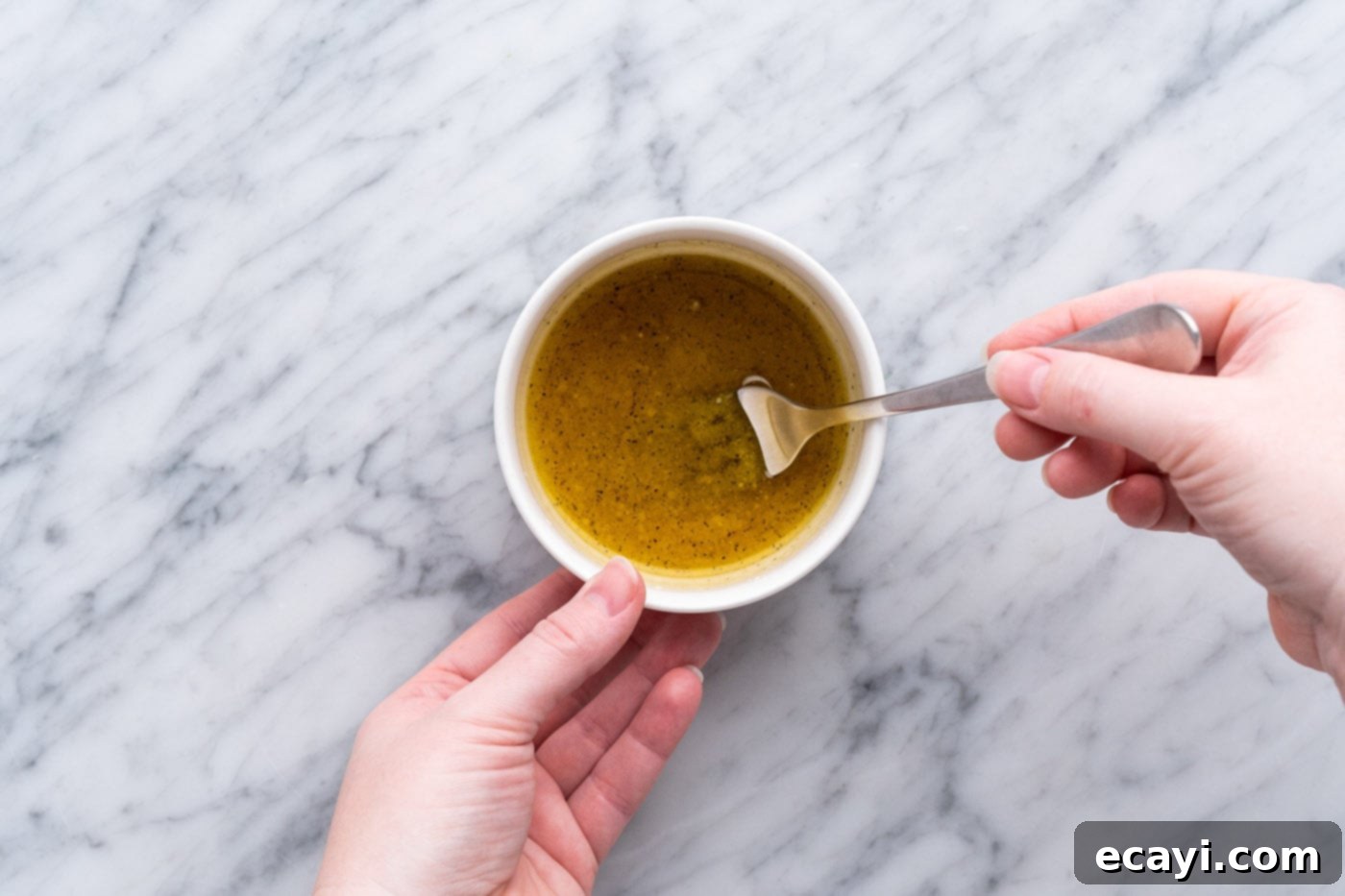
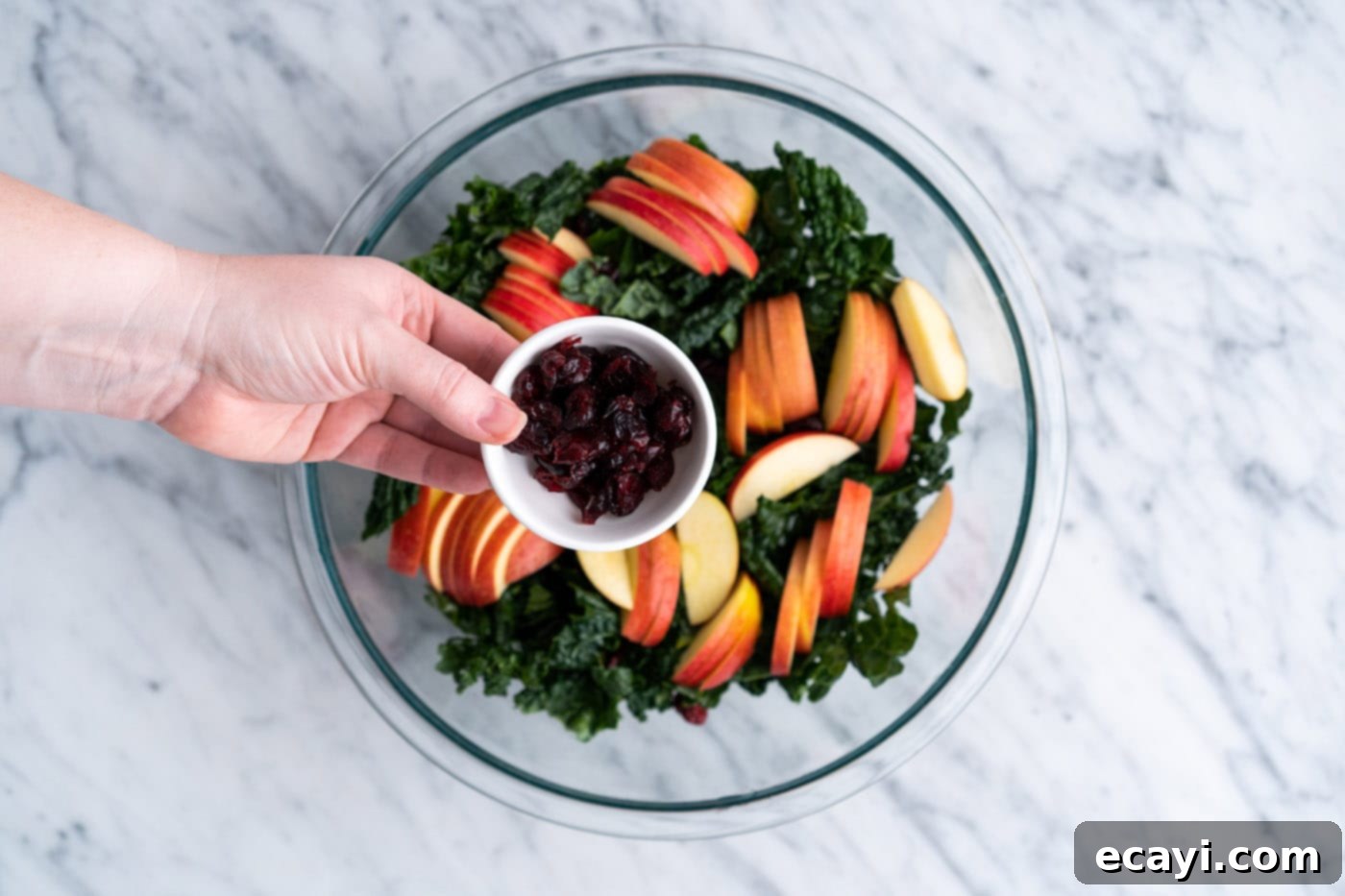
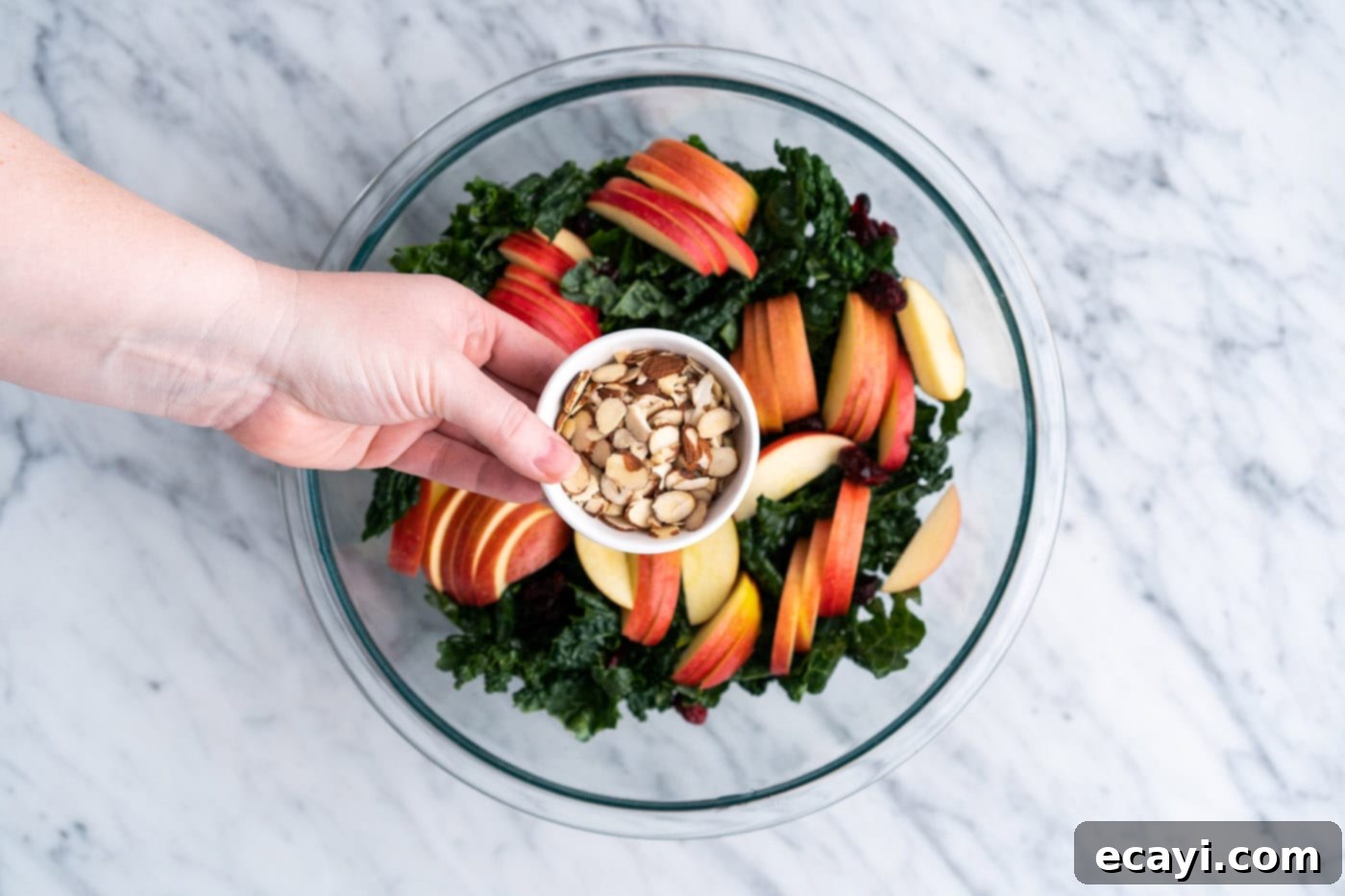
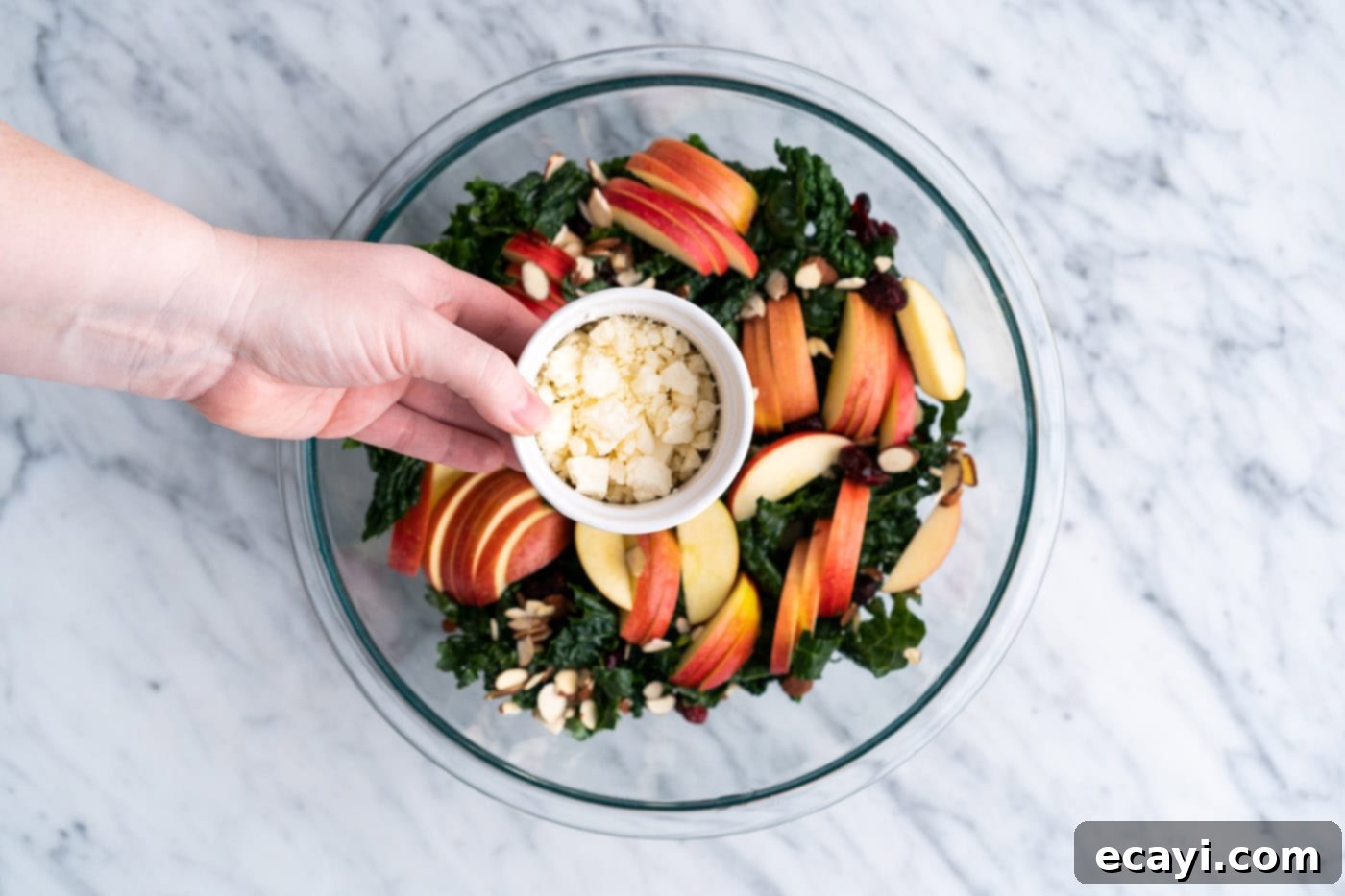
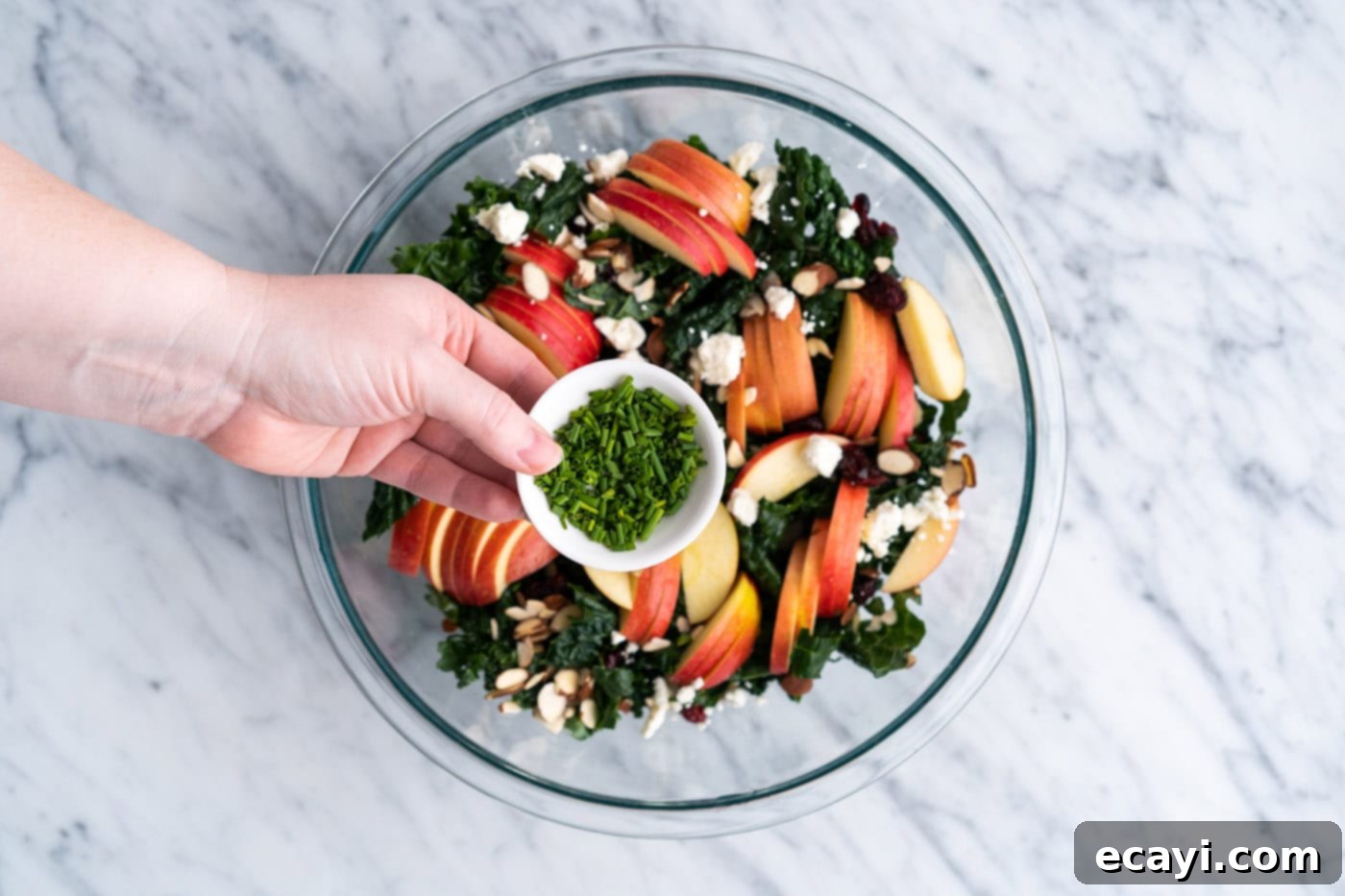
Frequently Asked Questions & Expert Tips
Massaging kale is a game-changer when eating it raw in salads. It tenderizes the tough leaves, reduces bitterness, and makes the kale much easier and more pleasant to chew and digest. To massage kale effectively, first, ensure the kale is washed, stems are removed, and the leaves are chopped into bite-sized pieces. Place the chopped kale in a large bowl. Drizzle about 1/2 tablespoon of extra-virgin olive oil and sprinkle 1/8 teaspoon of salt over the leaves. Now, using your clean fingertips, gently but firmly massage the oil and salt into the kale. Squeeze, rub, and scrunch the leaves for about 2-3 minutes. You’ll notice the kale becoming softer, darker green, and slightly wilted – that’s when you know it’s ready. Let it sit for 10 minutes to further tenderize before adding other ingredients and proceeding with the recipe. This simple step makes a world of difference!
Storing kale salad properly can help maintain its freshness. If your salad has already been tossed with dressing, it’s best consumed within 1-2 days when stored in an airtight container in the refrigerator. The acid in the dressing will gradually break down the kale, potentially making it mushy over time. For optimal freshness and to prevent sogginess, it’s highly recommended to serve the dressing on the side. This way, any leftover undressed salad (kale, apples, craisins, almonds, feta, chives) can be stored separately in the fridge for up to 3-4 days. The homemade fresh lemon dressing itself will keep beautifully in a sealed glass jar in the refrigerator for up to 1 week. Before each use, simply let it sit at room temperature for about 10 minutes to allow the olive oil to liquefy if it has solidified, then give it a good shake to re-emulsify the ingredients.
Yes, you can certainly prepare components of this kale salad in advance for quick assembly later. The lemon dressing can be made up to a week ahead and stored in the refrigerator. The kale can be washed, de-stemmed, chopped, and even massaged a day in advance; just store it in an airtight container with a paper towel to absorb excess moisture. The apples are best sliced right before serving to prevent browning, but you can have the craisins, almonds, feta, and chives ready to go. Assemble the full salad just before serving, or keep the dressing separate for meal prep throughout the week.
While the recipe works well with most varieties of kale, curly kale is a classic choice for its hearty texture and ability to hold up to dressing. Lacinato kale (also known as dinosaur kale) is another excellent option; its flatter, darker leaves have a slightly sweeter and more tender bite, which can be very appealing. If you prefer a milder flavor and softer texture, baby kale is a fantastic choice and often requires less massaging. Ultimately, choose the type of kale you enjoy most or the one most readily available and fresh at your local market!
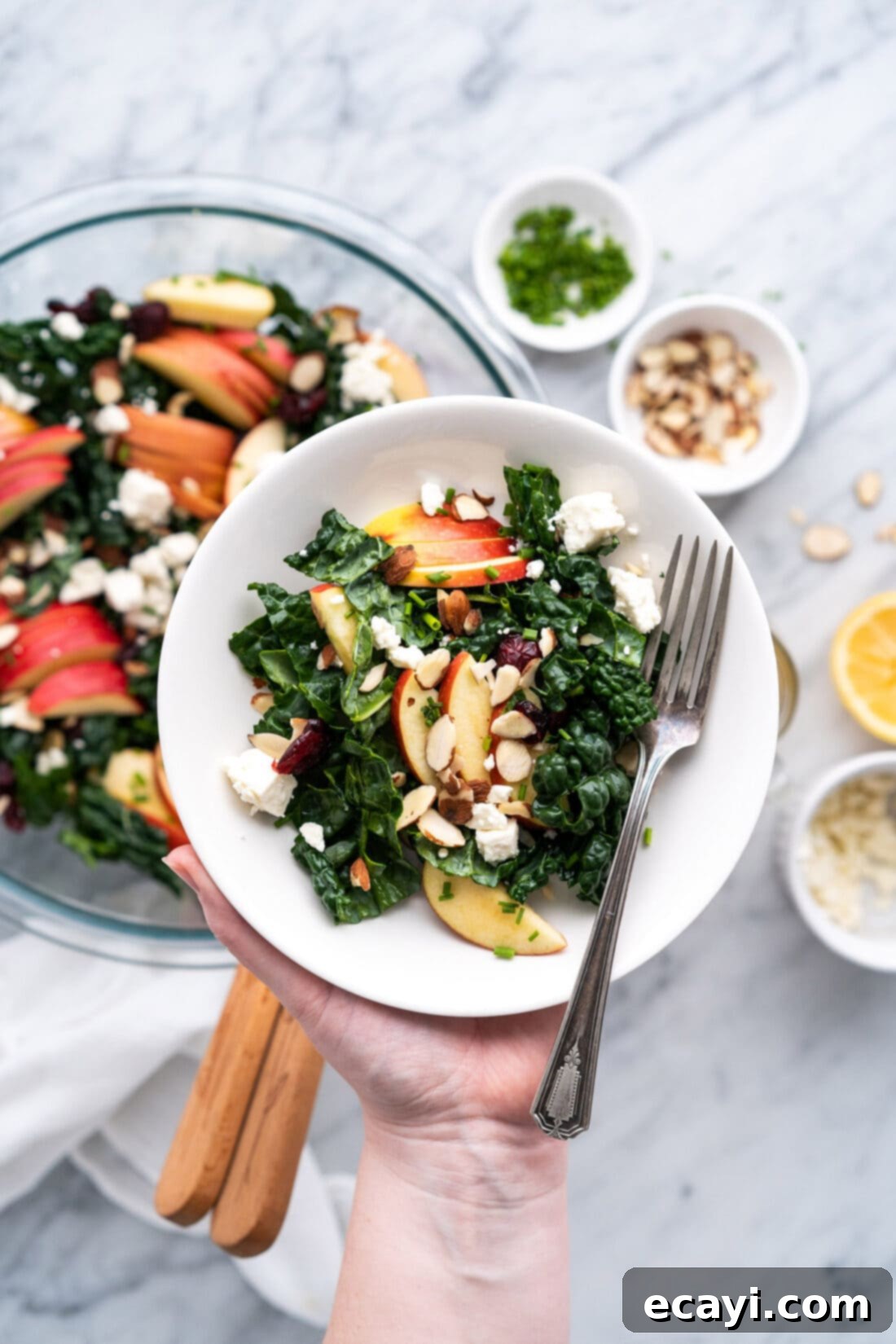
Elevate Your Meal: Serving Suggestions
This versatile kale salad is perfect for a variety of occasions and pairings. Serve it artfully tossed in a large salad bowl, allowing guests to help themselves to this fresh and vibrant dish. Alternatively, present the dressing on the side in a small pitcher or cruet, giving everyone the freedom to add as much or as little as they prefer. This salad truly shines as a fantastic light lunch on its own, offering satisfying flavors and nutrients. It also makes a wonderfully delicious and wholesome dinner side dish, complementing a wide array of main courses. Consider serving it alongside grilled chicken, baked salmon, a hearty lentil soup, or even a simple pasta dish. Its refreshing tang and satisfying crunch provide a perfect contrast to richer, warm entrees, making any meal feel complete and balanced.
Discover More Delicious Salad Recipes
If you’ve enjoyed this delightful kale salad, you’ll love exploring other fresh and flavorful salad creations. Here are a few more recipes to inspire your next culinary adventure:
- Classic Cobb Salad
- Crisp Wedge Salad with Blue Cheese Dressing
- Sweet & Savory Strawberry Salad
- Refreshing Watermelon Salad with Feta & Mint
- Pearl Couscous Salad with Feta and Beet
I love to bake and cook and share my kitchen experience with all of you! Remembering to come back each day can be tough, that’s why I offer a convenient newsletter every time a new recipe posts. Simply subscribe and start receiving your free daily recipes!
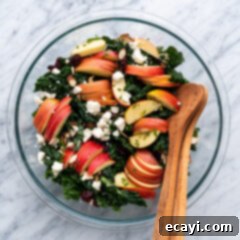
Kale Salad with Apples & Feta
IMPORTANT – There are often Frequently Asked Questions within the blog post that you may find helpful. Simply scroll back up to read them!
Print It
Pin It
Rate It
Save ItSaved!
Ingredients
Fresh Lemon Dressing
- 2 Tablespoons fresh lemon juice
- 3 Tablespoons extra-virgin olive oil
- ½ Tablespoon honey
- 1 teaspoon Dijon mustard
- ¼ teaspoon salt
- ⅛ teaspoon black pepper
Kale Salad
- 2 bunches kale stems removed and leaves chopped into bite-sized pieces (see Notes)
- 3 small apples cored and thinly sliced (see Notes)
- 4 Tablespoons craisins
- 4 Tablespoons sliced almonds
- 4 Tablespoons crumbled feta
- 2 Tablespoons fresh chopped chives
Things You’ll Need
-
Large salad bowl
-
Cutting board
-
Chef’s knife
Before You Begin
- To chop the kale, hold 1 leaf by the stem with one hand. Starting with the stem end, move your other hand down the length of the kale leaf, separating the leafy part from the stem. For this recipe, chop the leafy part and discard the stems.
- If desired, once the kale is chopped, toss it with 1/2 tablespoon extra-virgin olive oil and 1/8 teaspoon salt. Use your fingertips to massage the salt and oil into the kale leaves, and let it sit for 10 minutes before proceeding with the recipe. This step tenderizes the kale and reduces bitterness.
- You can use 1 large apple or 2 medium apples instead of 3 small-ish apples. Use any kind of apple that you enjoy eating out of hand, such as Honeycrisp or Fuji for their crispness and sweet-tart flavor.
- The lemon dressing can be easily customized. Add up to 1 teaspoon of minced fresh herbs, such as thyme, rosemary, oregano, or tarragon, for added aroma. A crushed clove of garlic can also be added for savory depth. Adjust the honey to match your preferred sweetness level.
- The fresh lemon dressing will keep well in a glass jar in the fridge for up to 1 week. Before using, let it sit at room temperature for 10 minutes, then shake well to re-emulsify.
Instructions
For the Dressing
-
Add all dressing ingredients (fresh lemon juice, extra-virgin olive oil, honey, Dijon mustard, salt, and black pepper) to a small bowl or glass jar, and whisk or shake together to thoroughly combine. Refrigerate until ready to use.
For the Salad
-
Place the chopped kale into a large salad bowl. Evenly arrange the thinly sliced apples, craisins, sliced almonds, crumbled feta, and fresh chopped chives on top of the kale.
-
You can either toss the entire salad with the prepared lemon dressing immediately before serving, or serve the dressing on the side to allow individuals to add it to their taste and prevent the salad from becoming soggy if there are leftovers. Enjoy your fresh and flavorful kale salad!
Nutrition
The recipes on this blog are tested with a conventional gas oven and gas stovetop. It’s important to note that some ovens, especially as they age, can cook and bake inconsistently. Using an inexpensive oven thermometer can assure you that your oven is truly heating to the proper temperature. If you use a toaster oven or countertop oven, please keep in mind that they may not distribute heat the same as a conventional full sized oven and you may need to adjust your cooking/baking times. In the case of recipes made with a pressure cooker, air fryer, slow cooker, or other appliance, a link to the appliances we use is listed within each respective recipe. For baking recipes where measurements are given by weight, please note that results may not be the same if cups are used instead, and we can’t guarantee success with that method.
